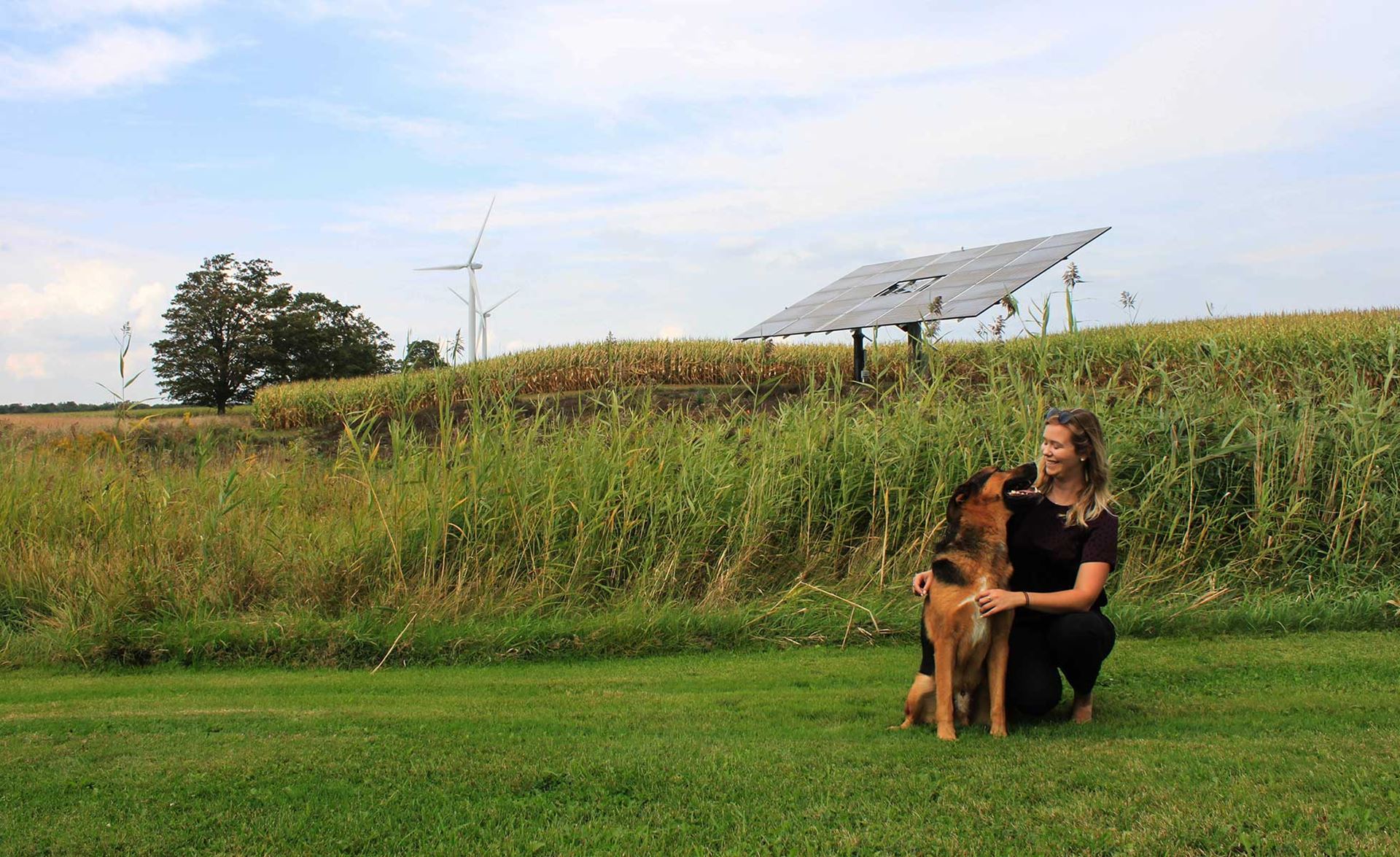
By Gideon Forman, Climate Change & Transportation Policy Analyst
Photos by Emily Fister
Miranda Fuller looks over the 10 turbines on Gunn's Hill Wind Farm in Southwestern Ontario's Oxford County, a lush region of farmland and small cities between London & Kitchener, "They're magical" she says.
The project, which started running in late 2016 and now produces enough electricity to power some 6,700 local homes, is Ontario’s first community-sponsored wind farm. If the word “magical” is not wholly accurate — the turbines are no illusion, after all — it does capture some of Gunn’s Hill’s uniqueness. From many points of view, it’s an extraordinary undertaking.
Fuller, 25, grew up in the town of Ingersoll in Oxford County and, after studying environmental ethics at nearby Wilfrid Laurier University, became communications director at the Oxford Community Energy Co-operative, one of the organizations that gave Gunn’s Hill life. Other key partners were the Six Nations of the Grand River and project developer Prowind Canada Inc.
She tells me the co-op of just 180 members raised a staggering $9 million — much of it from investments of $1,000 to $10,000 by individuals living in the county. Ron Seftel, CEO of investor Bullfrog Power says, “Local folks put in a ton of work” to make Gunn’s Hill possible. Today, almost half its bonds and shares, 49 per cent, are in the hands of Oxford residents and businesses. Community-based yet wonderfully ambitious, it is the largest renewable energy co-op project to gain approval in Ontario. It’s also Canada’s first wind initiative to feature both co-op and Indigenous ownership.
Beyond its significant size — it will supply an impressive 15 per cent of Oxford’s 100 per cent renewable electricity goal — the project creates a bond between citizens and their power generation.
“Too often, people are cut off from their power supply,” Fuller says. “It’s important to see your energy source. Seeing the turbines helps you connect with the energy you’re using.” Living close to the windmills — and in some cases gaining employment from them — gives locals a stake in the system and makes them more likely to support pro-renewable public policy.
Gunn’s Hill also helps conserve agricultural land. Fuller introduces me to the Start family, who joined the co-op partly because they’ve run a farm for six generations and want to protect it from developers.

The family’s connection to their land is intimate. Among the acres of wheat and corn, there’s a newly planted butterfly habitat between solar arrays.
“You’re just a steward. You never own,” Susan Start explains. “You’re just a steward of the land. So that was just really important to us, even on a spiritual level.”
The wind turbines are underwritten by 20-year contracts; putting them on the Starts’ property means it can’t be paved for at least two decades.
“We’re very close to an urban centre that will feel development pressure. It does now and will even more in the future,” says Susan’s husband, David, referring to the growing City of Woodstock. “We’re at the junction of [super highways] 403 and 401, two main corridors. And I believe the turbines will actually help protect this land and our woodlot for future generations — for local food production.”
Gunn’s Hill is also attractive to the Starts because it’s a joint venture with Indigenous Peoples.
“Another big thing for us was the involvement of the Six Nations,” Susan says. “I just find that community and that culture…wise, grounded, in touch with [the Earth].”
The project wasn’t without obstacles. During its development, Fuller recalls, “Some locals didn’t support it. But since it was built, we’re not seeing much pushback.”
David Start adds, “I think fear of the unknown was a factor for a lot of people who were sort of sitting on the fence and not knowing what to think. Now [the turbines are] up and they see them I think generally they’re thinking, ‘It’s not such a big deal. It’s not what I was told it was going to be.’”
One piece of information that diminishes opposition is the fact that wind turbines offer residents income. “Local people’s investment in wind does ease contention,” Fuller says.
“I absolutely worry about climate change,” she adds. “Denying it would be foolish. Wind is one of the technologies that can help us get off fossil fuel. It helps us become energy independent.”
Fuller, now executive director at the co-op, doesn’t hesitate to offer advice to other municipalities contemplating local power projects: “Be prepared to be surprised by the community’s passion for renewables. Keep moving forward — the end is worth it. They’re magical, the wind turbines. They bring a lot of hope.”
Renewable energy is empowering communities across the country. Charged Up is the story of you — of all of us — on a mission for a cleaner, healthier, charged-up Canada.
Ontario's First Community Wind Farm by Gideon Forman